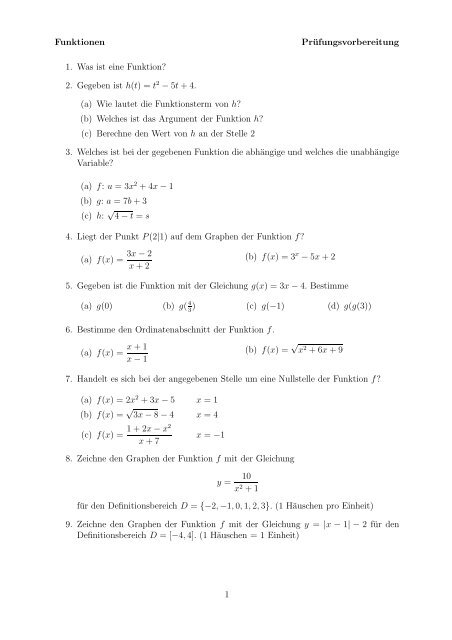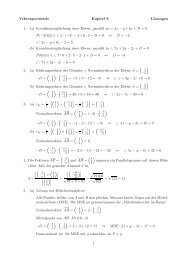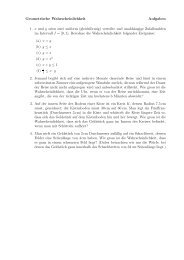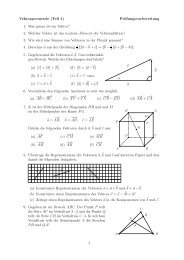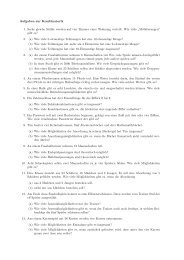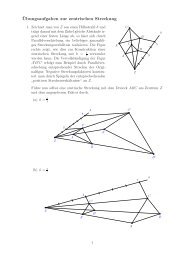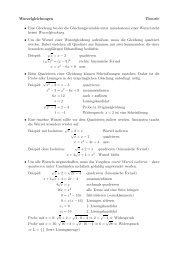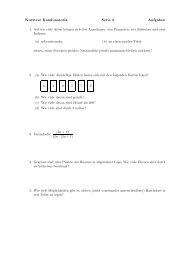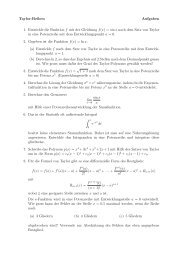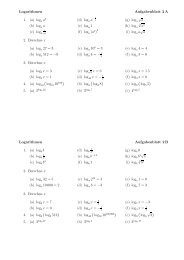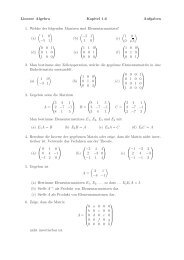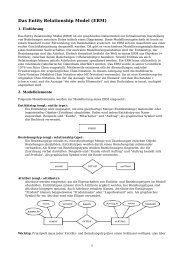Funktionen Prüfungsvorbereitung 1. Was ist eine Funktion ... - gxy.ch
Funktionen Prüfungsvorbereitung 1. Was ist eine Funktion ... - gxy.ch
Funktionen Prüfungsvorbereitung 1. Was ist eine Funktion ... - gxy.ch
Sie wollen auch ein ePaper? Erhöhen Sie die Reichweite Ihrer Titel.
YUMPU macht aus Druck-PDFs automatisch weboptimierte ePaper, die Google liebt.
10. Die <strong>Funktion</strong> f <strong>ist</strong> dur<strong>ch</strong> den folgenden Graphen gegeben.yy = f(x)1xBestimme die fehlenden Grössen.(a) f(1) =?(b) f(−5) =?(c) f(0) =?(d) f(<strong>1.</strong>5) =?(e) f(−π) =?(f) f(x) = 4, x =?(g) f(x) = −5, x =?(h) f(x) = 3, x =?(i) f(x) = 0, x =?1<strong>1.</strong> Vervollständige die Wertetabelle mit Hilfe der gegebenen <strong>Funktion</strong>sglei<strong>ch</strong>ung.(a) y = 3x−7 x −3 −1 0 10y 5(b) y = x 2 −4 x −20 −1 2 20y 012. Können die folgenden Wertetabellen zu <strong>eine</strong>r <strong>Funktion</strong> gehören?(a) x −4 −3 −2 −1 0 −1 −2 −3 −4y 9 8 7 6 5 4 3 2 1(b) x −4 −3 −2 −1 0 1 2 3 4y 6 8 4 0 2 ±4 0 6 113. Gib den Ordinatenabs<strong>ch</strong>nitt, die Nullstelle und die Steigung des Graphen der <strong>Funktion</strong>mit der Glei<strong>ch</strong>ung f(x) = − 4 x+ 1 an. Steigt oder fällt der Graph?7 214. Lies die Glei<strong>ch</strong>ung der linearen <strong>Funktion</strong> f aus demGraphen ab.yy=f(x)11x15. Zei<strong>ch</strong>ne den Graphen der <strong>Funktion</strong> f mit der Glei<strong>ch</strong>ung f(x) = − 2 x + 5 für den3Definitionsberei<strong>ch</strong> D = [−5,5]. (1 Häus<strong>ch</strong>en pro Einheit)16. Bestimme den S<strong>ch</strong>nittpunkt der Graphen der <strong><strong>Funktion</strong>en</strong> mit den Glei<strong>ch</strong>ungenf(x) = 2x+3 und g(x) = − 1 3 x−4.17. Bestimme die Glei<strong>ch</strong>ung der linearen <strong>Funktion</strong>, deren Graph dur<strong>ch</strong> die PunkteA(11|7) und B(13|−9) geht.2
<strong><strong>Funktion</strong>en</strong> Lösungen Prüfungsvorbereitung<strong>1.</strong> Eine Vors<strong>ch</strong>rift, die jedem Element <strong>eine</strong>r Definitionsmenge genau ein Element <strong>eine</strong>rWertemenge zuordnet.2. (a) t 2 −5t+4(b) t(c) h(2) = 4−10+4 = −23. (a) • x <strong>ist</strong> die unabhängige Variable• u <strong>ist</strong> die abhängige Variable(b) • b <strong>ist</strong> die unabhängige Variable• a <strong>ist</strong> die abhängige Variable(c) • t <strong>ist</strong> die unabhängige Variable• s <strong>ist</strong> die abhängige Variable4. (a) ja, denn f(2) = 1(b) ja, denn f(2) = 15. (a) g(0) = −4(b) g( 4 3 ) = 0(c) g(−1) = −7(d) g(g(3)) = 116. (a) f(0) = 1/(−1) = −1 (b) f(x) = √ 0+0+9 = 37. (a) ja, denn f(1) = 2+3−5 = 0(b) nein, denn f(4) = √ 12−4−4 = −2(c) nein, denn 1−2−1 = − 1 6 38. x −2 −1 0 1 2 3y 2 5 10 5 2 1yy=f(x)11x1
9.y1y=f(x)1x10. (a) f(1) = 1(b) f(−5) = 0.5(c) f(0) = 3(d) f(<strong>1.</strong>5) = 0(e) f(−π) = 1(f) f(x) = 4 ⇒ x = 9(g) f(x) = −5, –(h) f(x) = 3 ⇒ x = 0 oder x = 8(i) f(x) = 0 ⇒ x = −6 oder x = <strong>1.</strong>5 oder x = 6 1 31<strong>1.</strong> (a) y = 3x−7x −3 −1 0 4 10y −16 −10 −7 5 23(b) y = x 2 −4x −20 −1 ±2 2 20y 396 −3 0 0 39612. (a) Nein, da z.B. dem Element x = −4 aus der Definitionsmenge sowohl der Werty = 9 als au<strong>ch</strong> der Wert y = 1 zugeordnet wird, was bei <strong>eine</strong>r <strong>Funktion</strong> ni<strong>ch</strong>terlaubt <strong>ist</strong>.(b) Nein, da dem Element x = 1 aus der Definitionsmenge sowohl der Wert y = +4alsau<strong>ch</strong>derWerty = −4zugeordnet wird, wasbei<strong>eine</strong>r <strong>Funktion</strong>ni<strong>ch</strong>t erlaubt<strong>ist</strong>.13. • Ordinatenabs<strong>ch</strong>nitt: y = 1 2• Nullstelle: − 4 7 x+ 1 2 = 0|| + 4 7 x1= 4 x || ·142 77 = 8x || : 8x = 7 8• Steigung: − 4 7• Fallend, da m < 014. f(x) = − 4 5 x+2 2
15.yy=f(x)11x16. • <strong>Funktion</strong>sglei<strong>ch</strong>ungen glei<strong>ch</strong>setzen.2x+3 = − 1 x−4 || ·336x+9 = −x−127x = −21x = −3• x S = −3 zum Beispiel in f(x) = 2x+3 einsetzen: y S = 2·(−3)+3 = −3• S<strong>ch</strong>nittpunkt: S(x S |y S ) = S(−3|−3)17. • Skelett: y = mx+q• Steigung: m = ∆y∆x = −16 = −82• A(11|7) bedeutet x = 11 und y = 7:7 = −8·11+q ⇒ 7 = −88+q ⇒ q = 95• <strong>Funktion</strong>sglei<strong>ch</strong>ung: y = −8x+953


